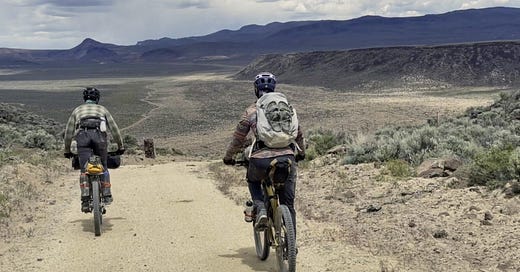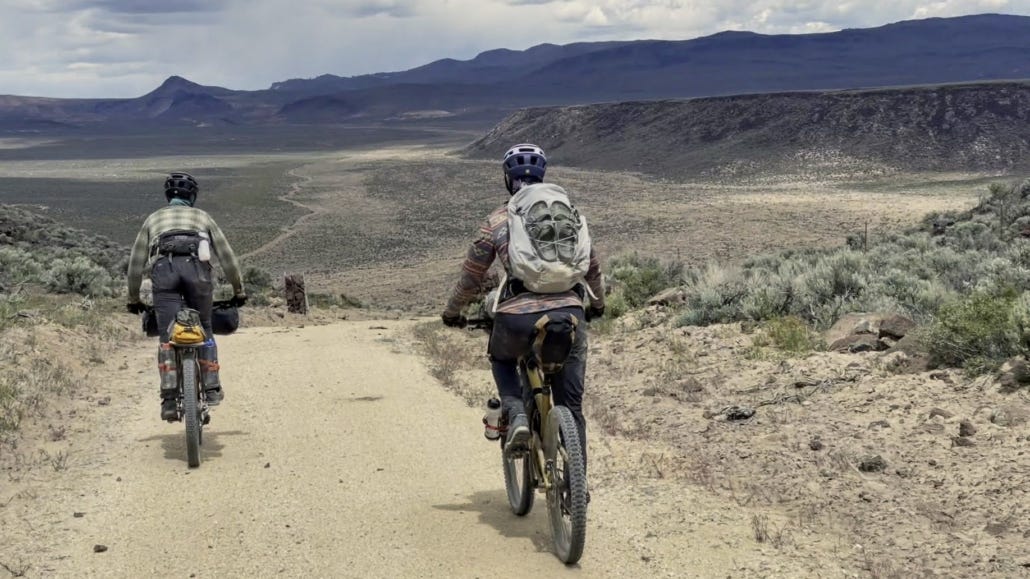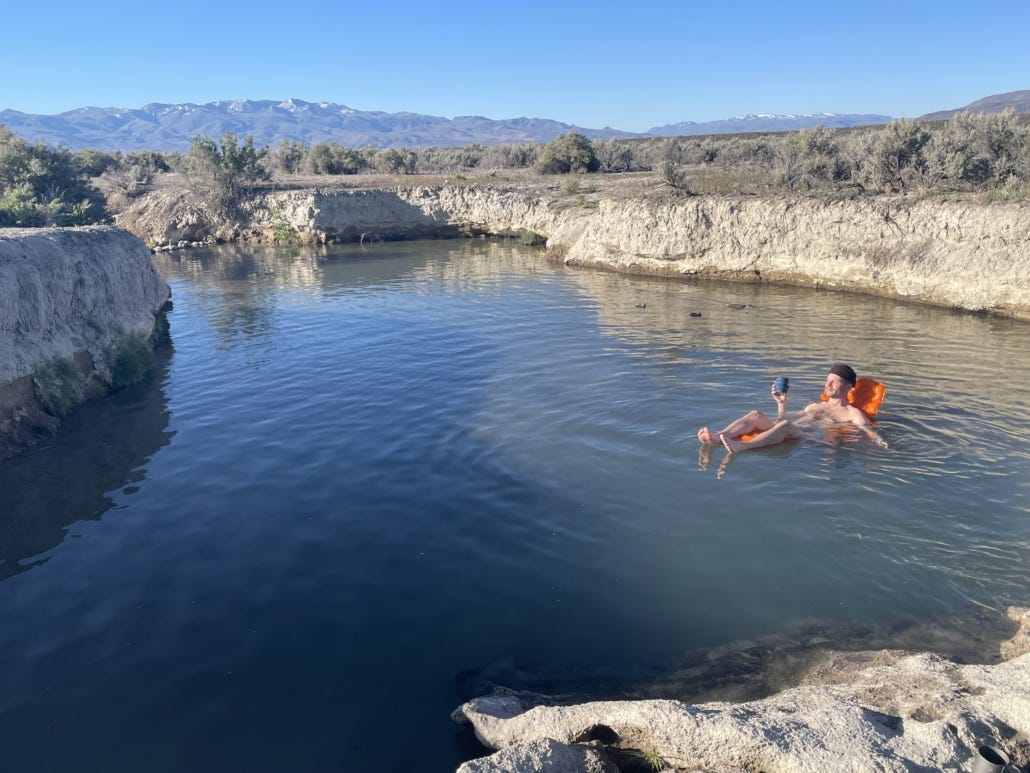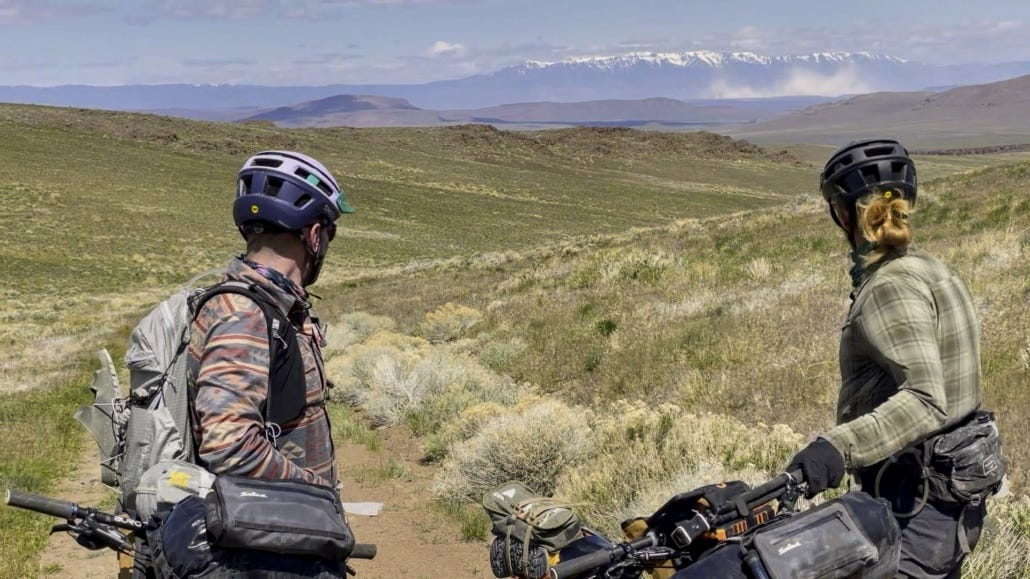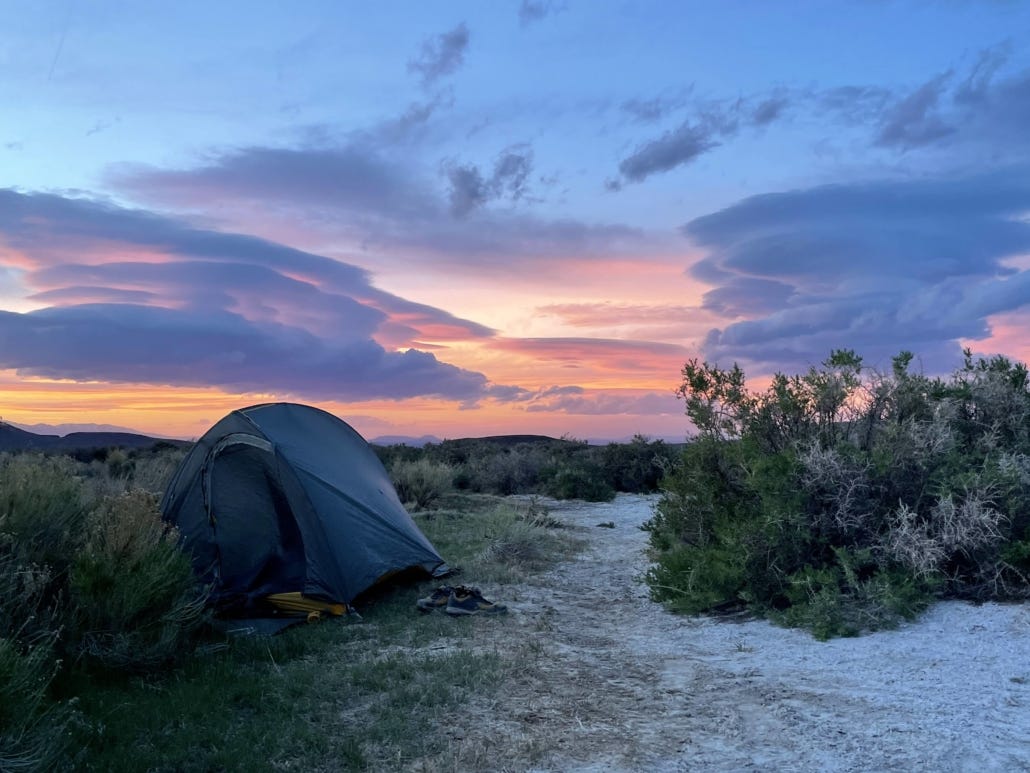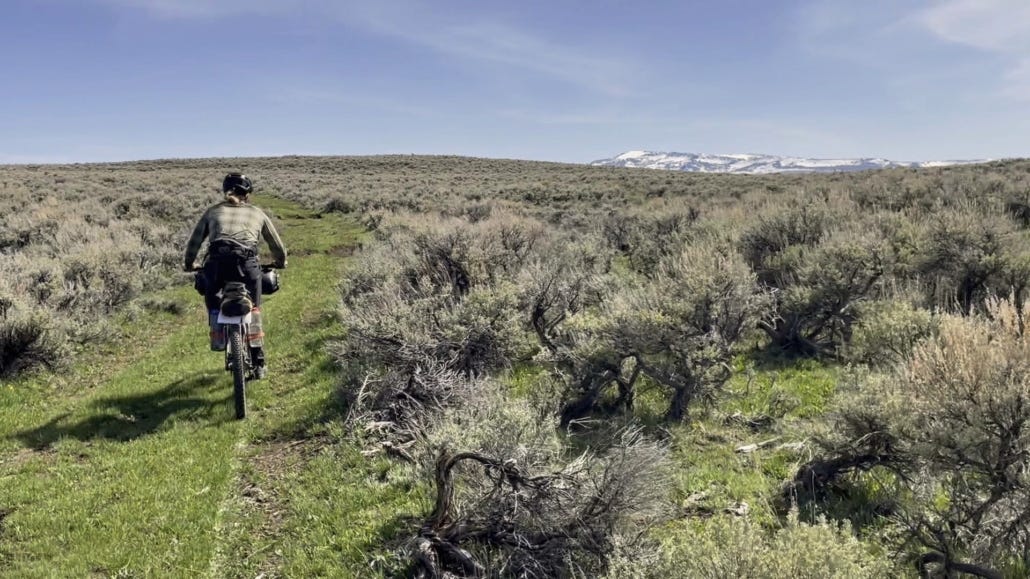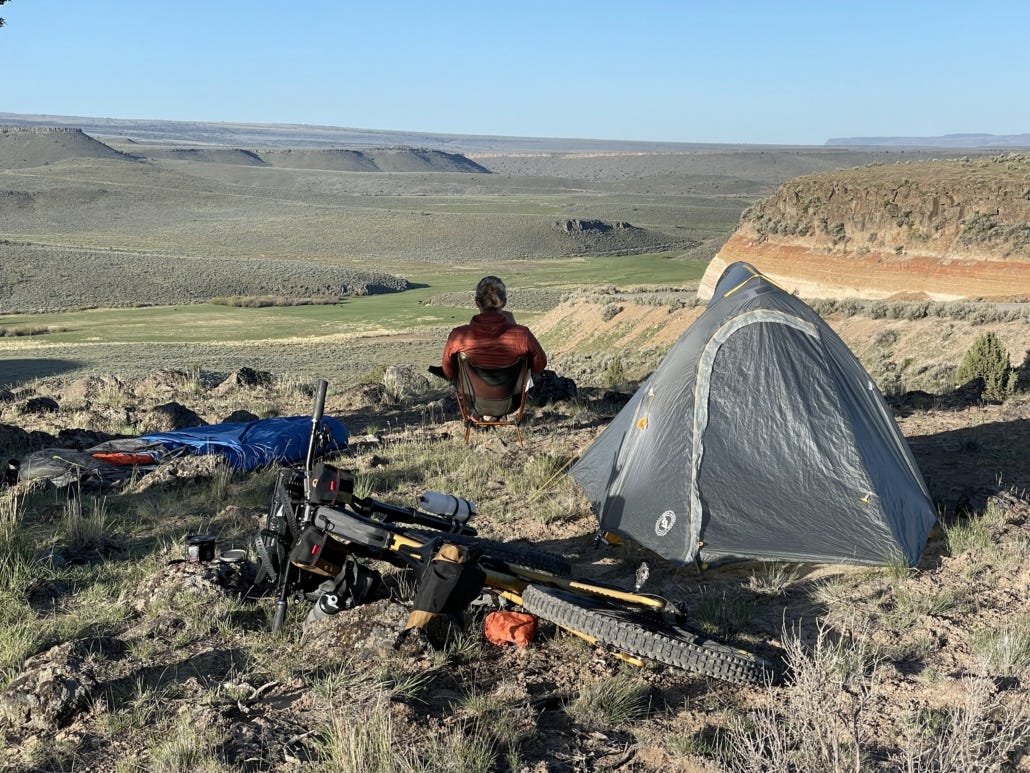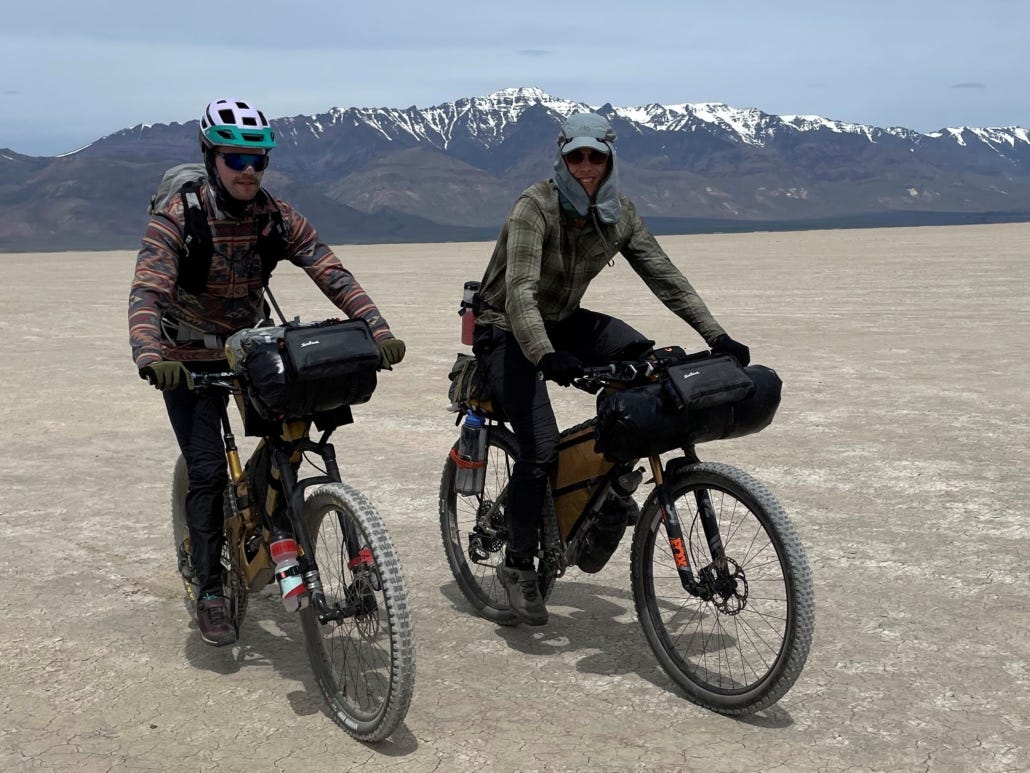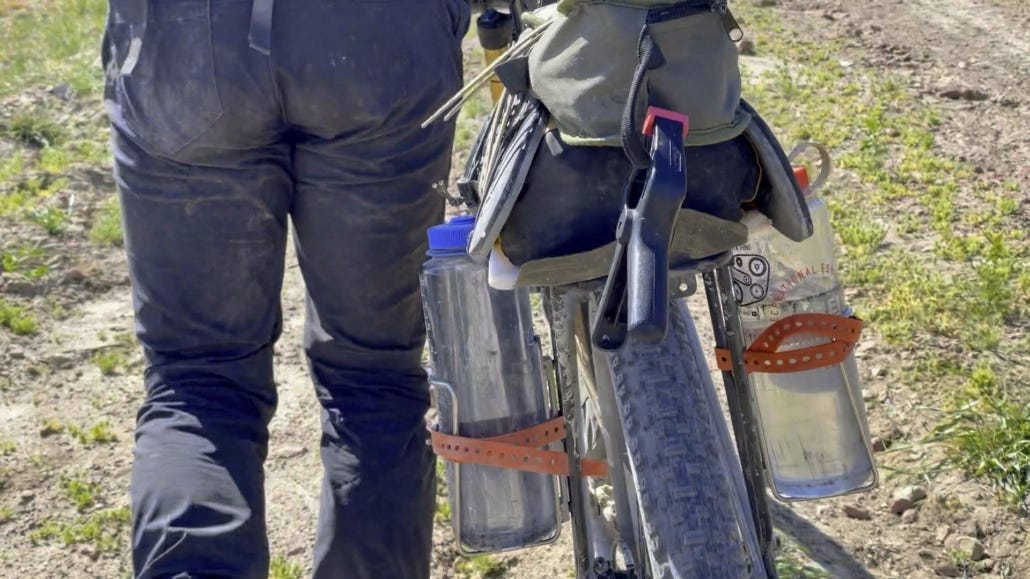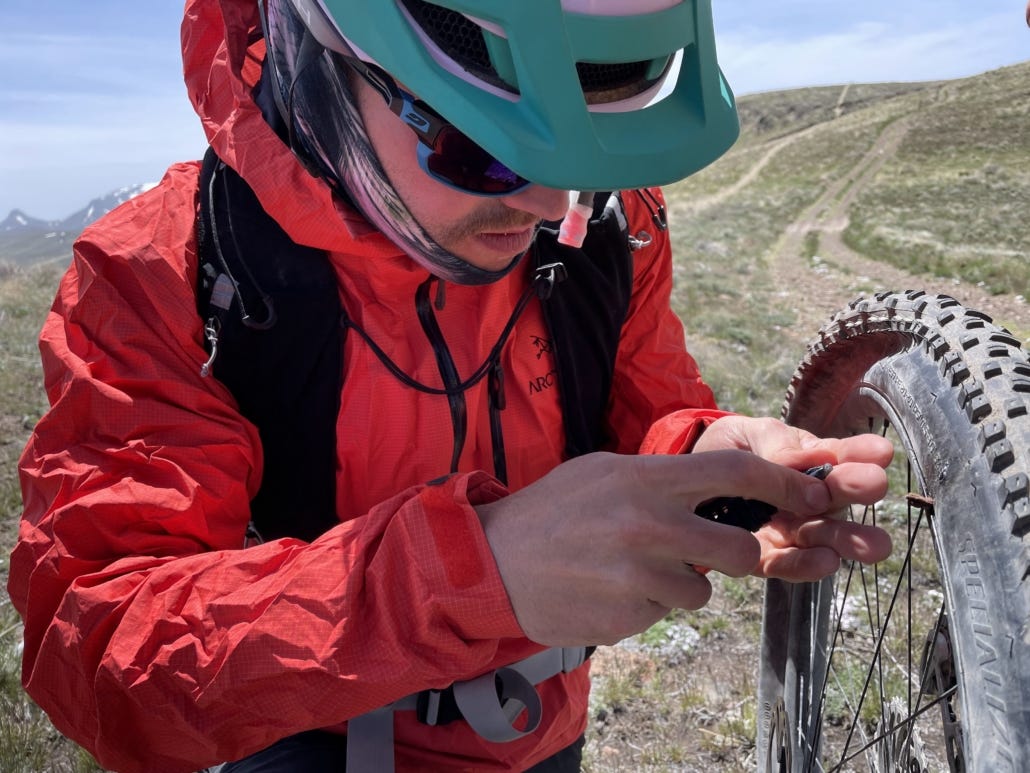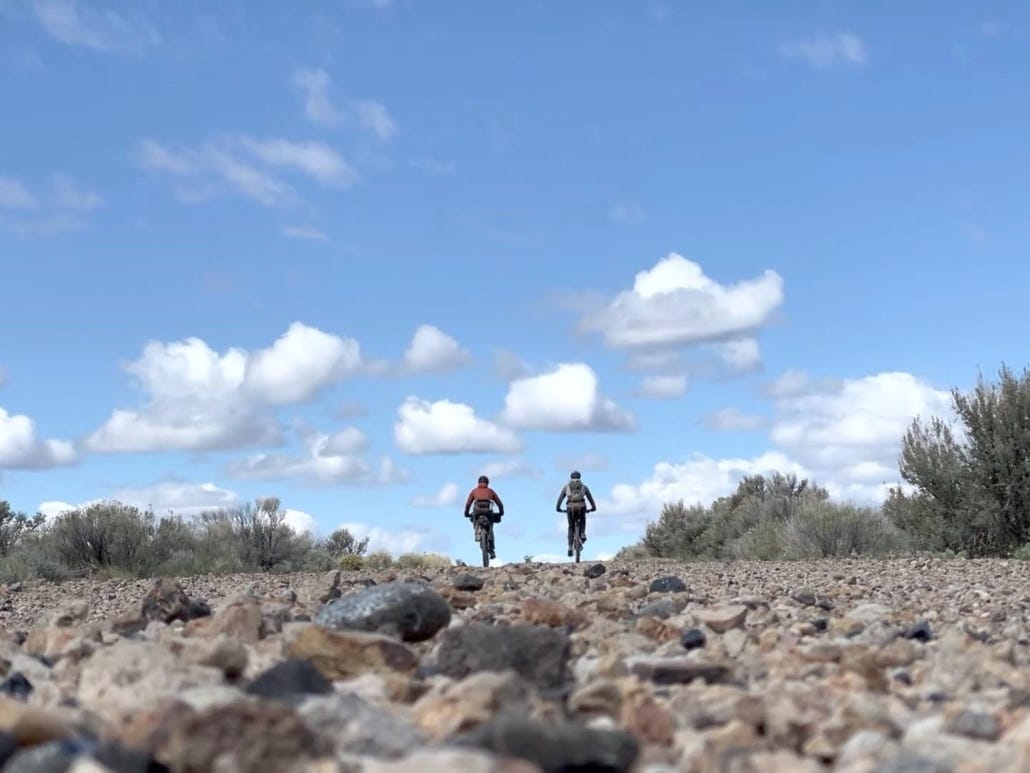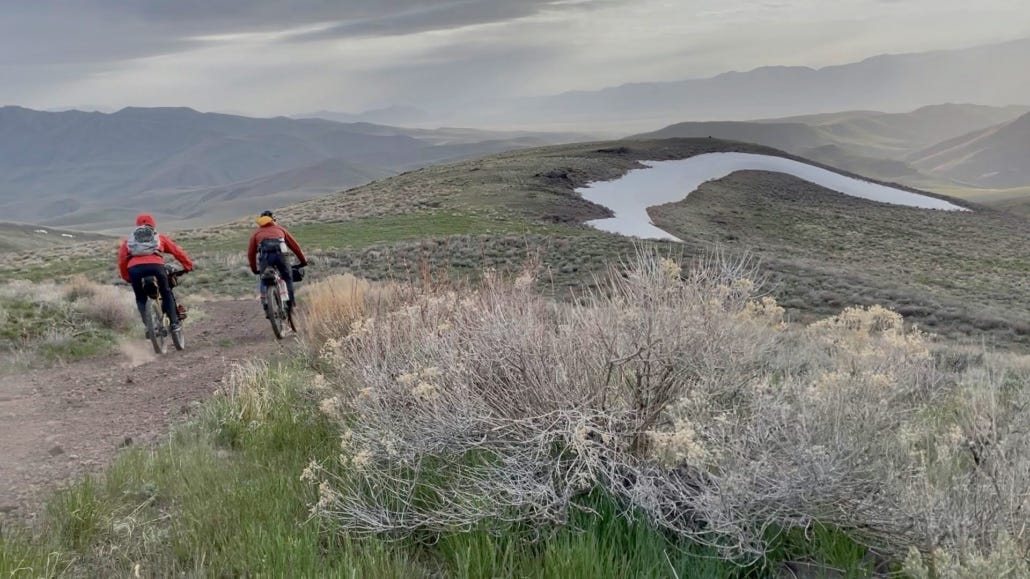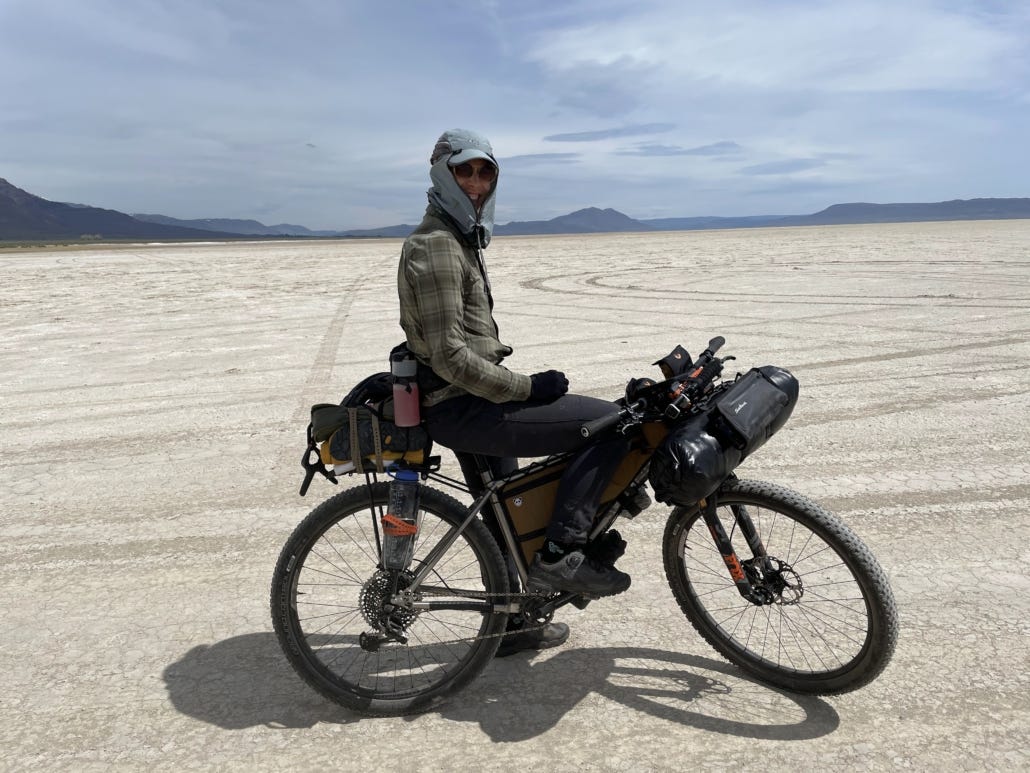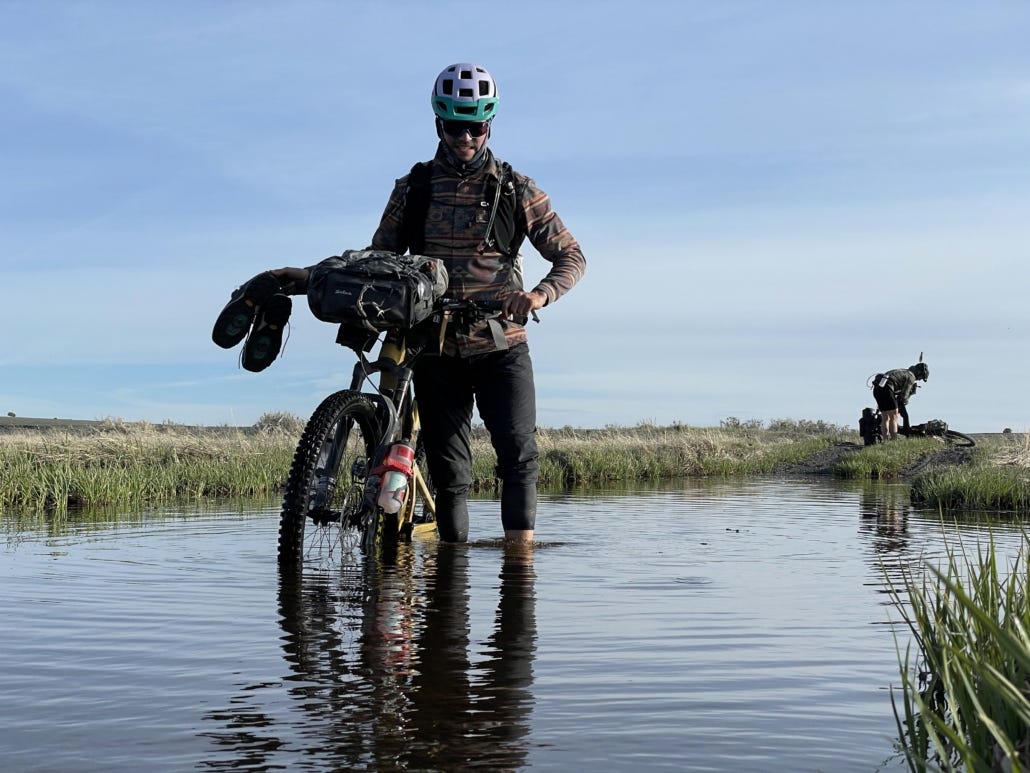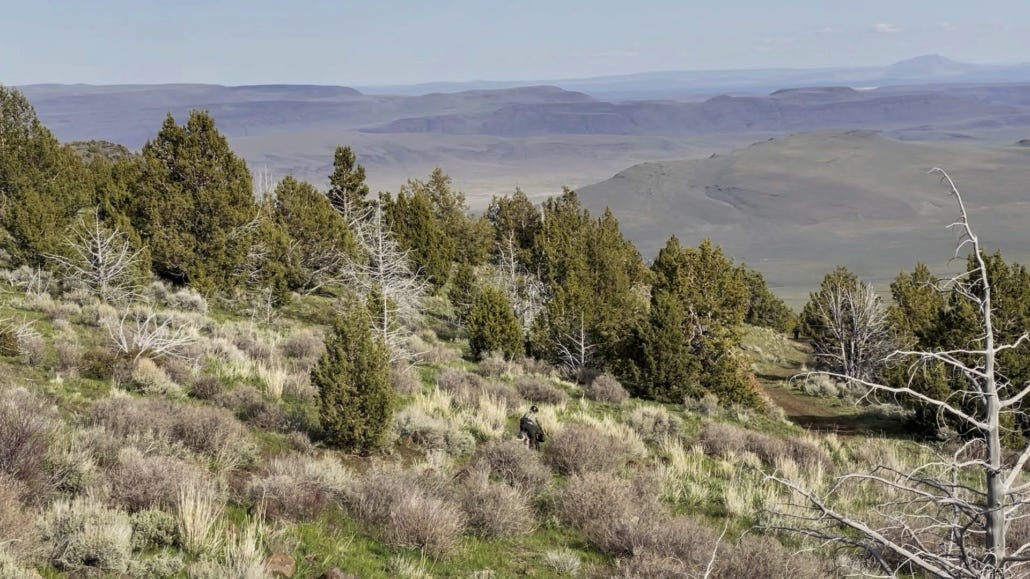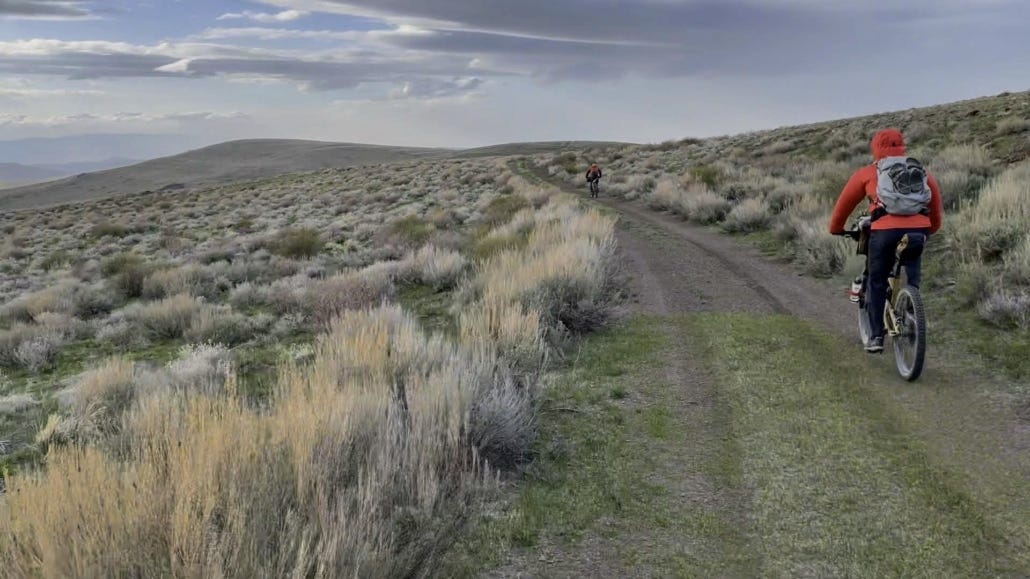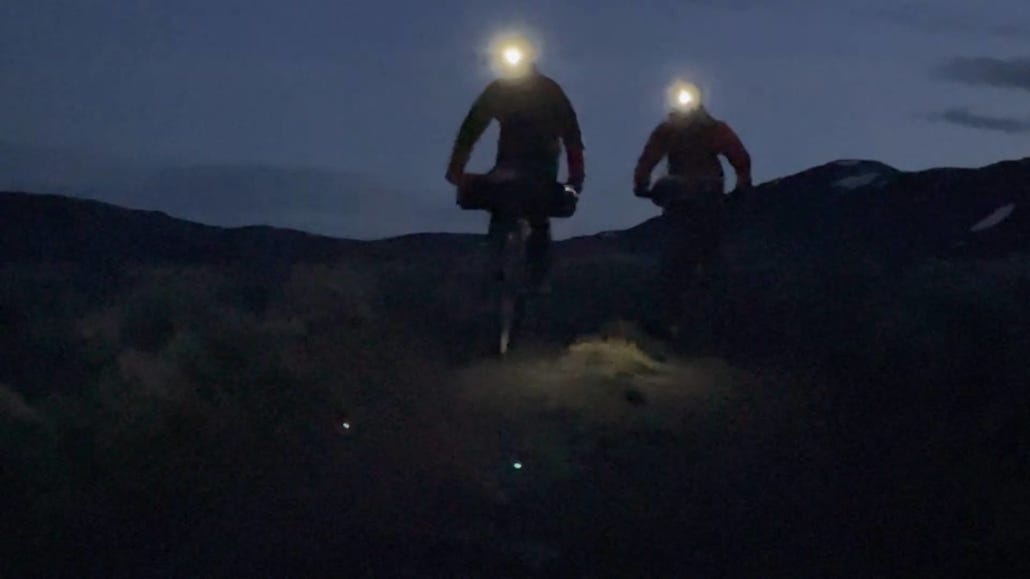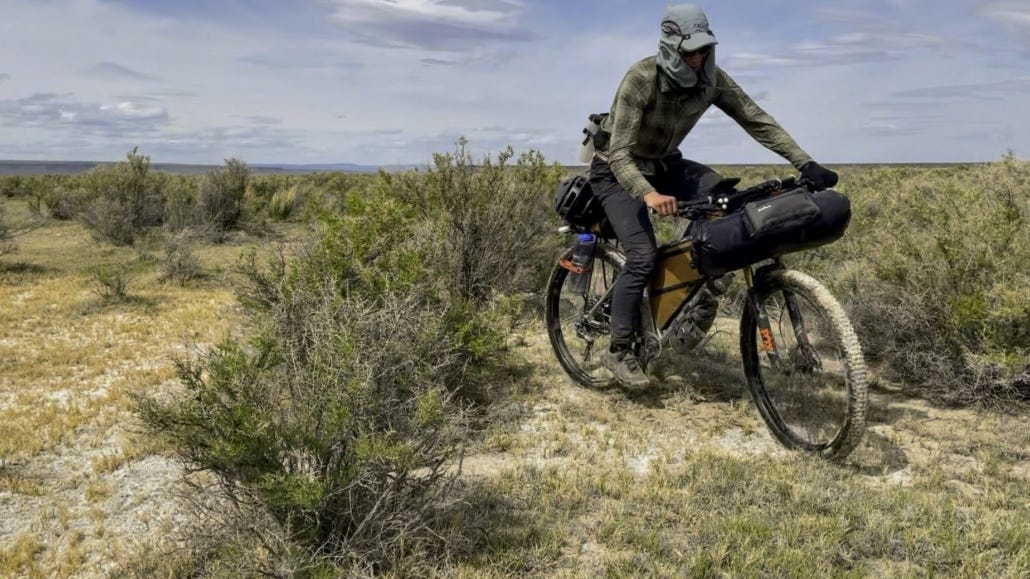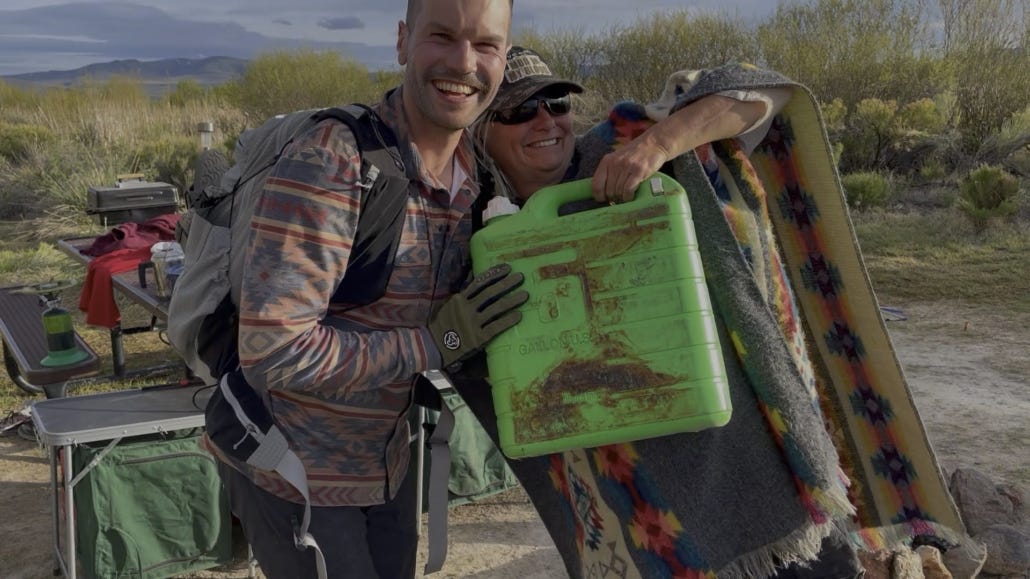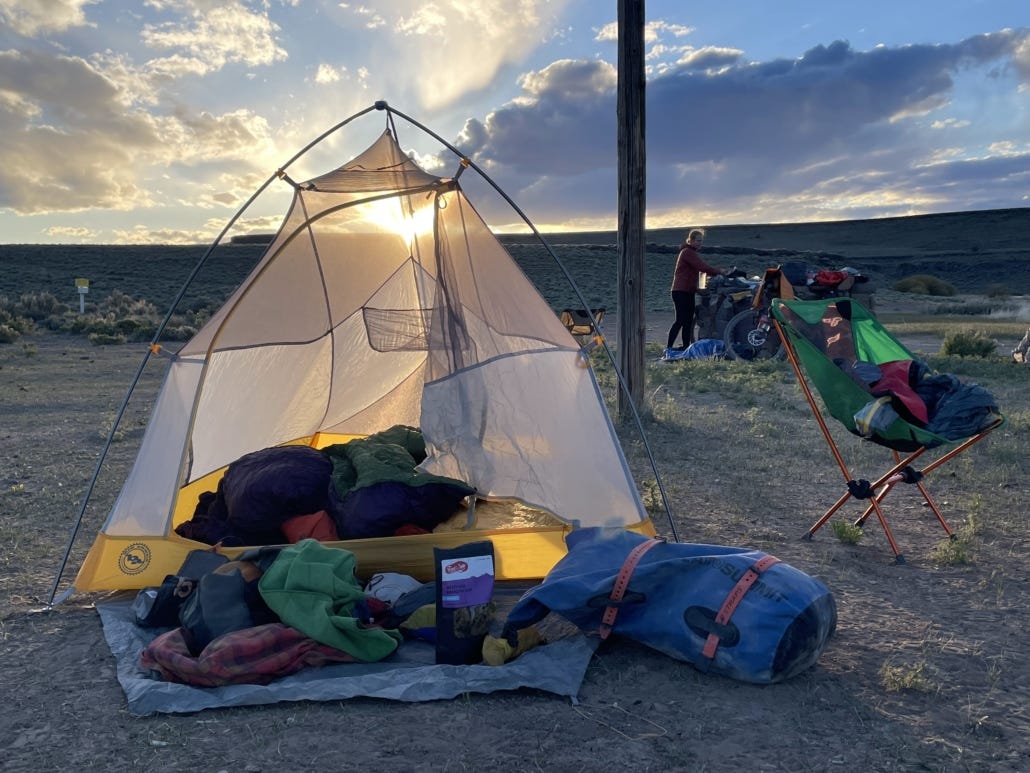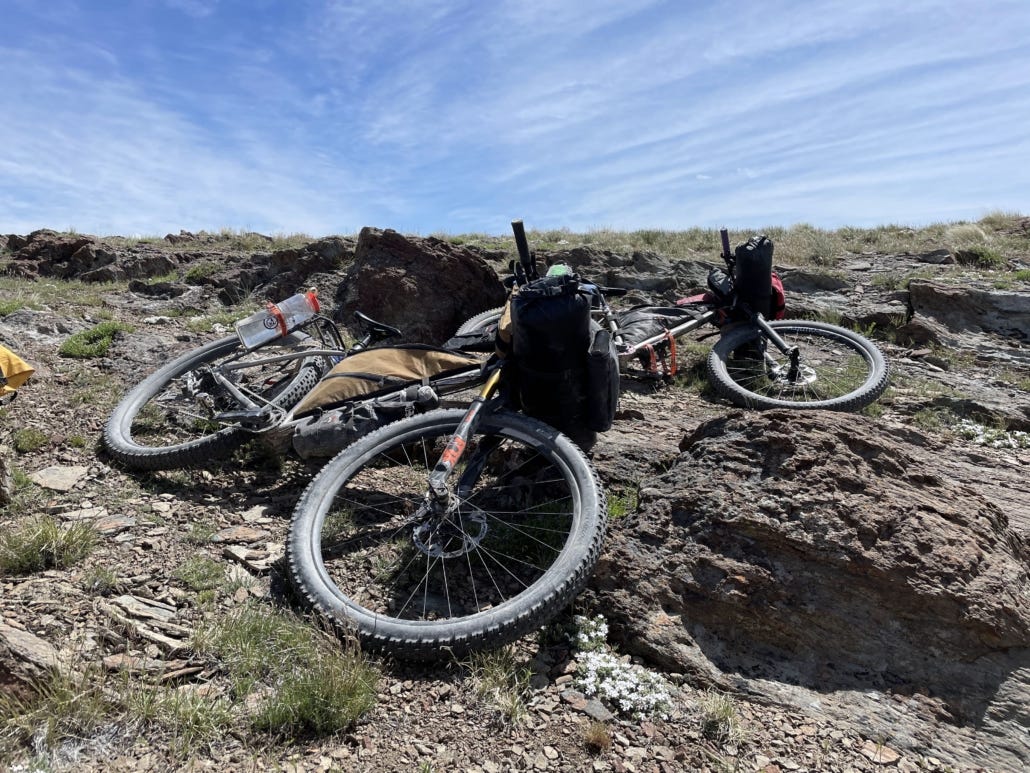
Bikepacking the Oregon Big Country route
Hot springs, wide open territory, and a whole lotta solitude in SE Oregon.
Way out yonder in SE Oregon lies the Oregon Big Country bikepacking route. If you’re looking for a remote desert getaway, you’ve found it.
Overall, I expected cruisy gravel roads, mild vertical gain, and hot springs to soothe bikepacking soreness.
I nailed 1 out of 3: the hot springs were amazing.
In reality, the Big Country route served up a variety plate of different terrain ranging from desert playa up to snowy mountains. I’ve bikepacked and road toured a lot and this trip surprised me with the physical difficulty, remoteness, commitment level, and sheer beauty.
Shortcuts for Oregon Big Country:
Below I share snippets of my experience bikepacking the Oregon Big Country. I wrote this as a resource for folks looking to bikepack this route, so free to skip to any specific sections below.
Daily summary of our trip (mileage, elevation, camp spots)
Oregon Big Country Route Description and Overview
The Big Country is a ~360 mile loop starting in French Glen, a tiny town on the west side of the Steens Mountain range in SE Oregon. Terrain varies from gravel to pavement to “where in TARNATION is that 1852 wagon trail?”
You’ll wander down into Nevada, roll across a full-on desert. You'll find places to fill up on water about as often as you see people: rarely. The fickle weather might shut your trip down entirely if the Dread Mud is activated. The only shade comes from circling vultures (I’ve always wanted to say that).
In other words, it’s the best kind of adventure, chock full of places rarely visited, pronghorn antelope bouncing along, starry skies for days, and a fine tale for the folks back home.
Oh, and don’t forget the hot springs!
Check out the Big Country route writeup from Limberlost on Bikepacking.com for more details.
My experience bikepacking the Oregon Big Country
When I bikepacked the Oregon Timber Trail, I’d routinely complain when we hit fire roads vs. singletrack. What can I say, I like trail riding! (Cough, snob alert.)
Wellll, the Oregon Big Country features exactly zero singletrack, and I still dug it. The Big C served up a tasty cocktail of desert landscapes, remoteness, hot springs, and a chance to immerse myself in a part of Oregon I seldom visit, bermed trails be damned.
Most of our days on the bike unspooled lazily. We weren’t pushing too hard—and didn’t want to. Ample space for joking around during snack breaks and chatting with overlanders at Bogg Hot Springs or Gatorade-offering bird watchers in Malheur Refuge!
Our first night featured a full moon backed by a symphony of howling coyotes. That yielded to a silent morning campsite where I sipped tea and stared across the mesas thinking “this is what it’s all about.” Following sage and rough ranch doubletrack, we climbed over the Steens to the rowdy and rad Stonehouse Road descent. (May I never ride up it!)
Water is always at a premium during the Big Country. We filtered from trickling streams in cow pastures or boggy reservoirs. A few kind hot springs car-campers saw us doing so and offered up a water donation. “You can’t filter out of that nasty beaver pond! Here, take this jug, we’re leaving tomorrow anyway.” Generally, we tried to camp at water sources, but pickings were slim between those, so we each carried 5-6 liters at a time.
During a late night soak at Alvord Hot Springs, a string of 30 UFOs transfixed us as they streamed across the sky. I was willing to be abducted for a couple gallons of cold spring water, but they were just Elon’s Skylink satellites and offered nothing but fast internet.
Tailwinds the Phoenicians would have prayed for pushed us across the Alvord Desert, a dry lake bed. Our luck ran out in Big Sand Gap as we hiked in the hot sun, but good humor, lupini beans, and knowing it would end someday got us through it.
By the way, dig these kinds of posts? Sign up for the free 2x/month Traipsing About newsletter for more tales from the trail and creative challenges like drawing and piano when I'm off the bike.
I found a plastic workshop clamp at Alvord, which turned into a game of secretly depositing the clamp on each other for the next four days, trading it back and forth. "NOOO, not the clamp!" Subtle maneuvering and sleight of hand tactics escalated until some near-wrecks convinced us it was time to end the game.
The usual gear-testing (and MacGyver solutions) presented themselves. Chains broke. Bottom brackets loosened. Tires and sleeping pads punctured. My stove fuel failed in the cold. My new Platypus filter bag blew a hole in the side after 10 uses.
We swapped or shared gear, rallied. Mostly, things worked and mishaps were few. Good to have companions on a trip!
The Trout Creek Mountains delivered the promised hard work, plus temps dived toward freezing at 8k’. Cooold winds, but minimal snowy hike-a-bike. High on a ridge, wild horses cantered up to Mason.
Things grew more cruisy from the Trout Creek Mountains on day 5 as we hit smoother gravel and some pavement. We refueled our food supplies at Denio Junction Motel via a box I mailed ahead (do it!) and chatted with the gracious owner.
After a brilliant afternoon lazing away at Bogg Hot Springs, we spent our last three days traversing endless rolling ranch country in Sheldon and Hart Refuges. Occasionally pronghorn antelope streaked across the open landscape, but mostly we encountered friendly cows. The heat dial stayed turned down (HURRAH), making the hot springs delightful.
A return to aspen marked the final approach to Hart Hot Springs and our last night of the trip. We finished our final climb well past dusk and descended in the dark to camp beside a burbling stream.
A late night and morning hot springs dunk clinched the deal: this is a sweet bikepacking loop. If you like sage, solitude, and soaking after long bike rides, you can’t go wrong on the Oregon Big Country.
Logistics for bikepacking the Oregon Big Country
Tips and suggestions for the route
-If you want to check snow levels in the Trout Creek Mountains, call the closest ranger station. Call 541-473-3144. They were happy to help. (The Gaia app with snow layers works well too.) We bumped our trip from May 2 to 16th after a late-season week of snow in April.
-Bring as much sun protection as possible. We all wore helmets with a buff pulled up most of the time. Others wear wide brimmed hats or a Da Brim helmet attachment.
-Wind protection is quite nice. A buff kept my face from getting whipped raw.
-Mailing a package to the Denio Junction Motel was easy. Tiara and Alex (the new owners as of 2022) are fabulous, friendly people. Call ahead to double check, but they asked that we mail stuff to “Denio Junction Motel care of (your name)”. Restock options at the Motel are very limited, but they are ramping up.
-Big tires are your friend. Suspension is nice, especially the first 150 miles. Anything smaller than 2.4” could either slow you down, punish your body, or straight-up destroy your bike. My friend almost borrowed my old Salsa Fargo for the trip and we thought a half dozen times, “my god, this would be horrible on a Fargo!”
-Supposedly the water near Willow Creek is gross because of the beavers. Filter beforehand or head up really high to where less critters are? Or find some really nice people to give you some of theirs.
-Hart Mountain Trail is closed to vehicles until July 15th. There was no water from Sheldon Reservoir to past all the abandoned ranches. From there, we had plenty of water available to filter.
-The small pool at Hart Hot Springs is warmer vs. the Stone House.
-We took our shoes off for a half dozen water crossings. None of them felt unsafe though.
Daily summary of trip
We pedaled the loop in 8 days, including a late afternoon departure on day 1 and a half day from Hart to Frenchglen. I’d say 7-8 days is spot on for pacing if you want to experience a hot spring every other night vs. a dehydrating midday soak and continuing to pedal.
Day 1: 33 miles, cruisy gravel roads and pavement from Frenchglen to a brilliant campsite just past Diamond Hotel. We hit the road at 4:30 pm and arrived at dark without pushing too hard.
Day 2: 55 miles up and over the Steens to Alvord Hot Springs. Terrain is lightly used ranch ATV trails with plenty o’ rocks, so going was slooow. Enjoy that descent down Stonehouse Road to the east side, it’s da bomb. (Filter water from the stream on the way down!)
Day 3: About 30 flat miles from Alvord Hot Springs to Willow Creek Hot Springs. A surprise of a day…be prepared for it to take wayyy longer than the mileage and elevation suggest. Roll onto the Alvord and pedal across a straight-up desert. Survive Big Sand Gap. Wander around route finding in the swampy zones. Ford some creeks. Soak away your worries at Willow.
Day 4: Willow Creek to the other side of Trout Creek Mountains. A bruiser of a day. Windy as hell, COLD up high at 8k (below freezing), patches of snowy hike-a-bike…and beautiful. So beautiful. Be prepared for a physically challenging, exposed day of riding. (We did ~40 miles and climbed 6500'.)
Day 5: Trout Creek Mountains to Bogg Hot Springs, 35 miles. Ahhh, almost a day off! Cruisy gravel and paved roads, a stop at the Denio Junction Motel to pick up a box we mailed, and an early arrival at the fantastic hot springs to nap and kick back for the afternoon.
Day 6: Bogg Hot Springs to Sheldon Reserve, 52 miles. Gravel cruising into ATV trails to pavement to gravel for days. Since Virgin Valley Hot Springs was closed, we skipped it and rode the highway over the nearby climb.
Day 7: Sheldon to Hart Hot Springs, 55 miles. A long day out on rarely-used rancher double track. We didn’t see another person the entire day until arriving at the (marvelous) Hart Hot springs.
Day 8: Hart Hot Springs back to Frenchglen, 55 miles. We lazed around all morning at the hot springs, then gunned it for the car on wide, fast, boring gravel roads. (My least favorite kind…)
Getting to/from start/finish
Frenchglen rhymes with nowhere and is close to nothing, so getting there is up to you and your vehicle. At least the route is a loop! Get in the car and drive, then pedal your way clockwise back to your rig.
The friendly owner of the Frenchglen Hotel is totally cool with people leaving rigs. We donated some cash for parking afterward.
Time of year
There’s no perfect time to ride the Big Country, merely options. We initially planned on May 2nd, but late-season snow forced us to bump our trip to May 16th.
I’m glad we did because we still needed to do some hike-a-bike through snow in the Trout Creek Mountains. To check snow levels beforehand, call the local ranger station at 541-473-3144 or use the Gaia snow layers.
In mid-May, nights dipped into sub-freezing temperatures. Overall, I’d still vote for that time of year because:
a) days are cooler and there is SO little shade. Pedaling in 90 degrees in low-water terrain = yikes.
b) hot springs feel way better when it’s cold vs. hot.
c) seasonal springs dry up later in the season and water is not plentiful on this route.
Navigation
Navigation was straight-forward thanks to the route GPX from bikepacking.com. As usual, I used Ride with GPS to navigate. There were a few swampy or sandy sections that were tougher to navigate, but generally the track was apparent. Even if it had last been traversed in the 1850s… Thanks to Gabe at Limberlost for putting this together!
Food
As usual, I rolled on a plant-based diet for this trip, eating freeze-dried meals the entire way.
I ate a variety of freeze-dried meals, including delicious Food for the Sole, Backpacker’s Pantry Pad Thai, and the (too spicy!) Good To-Go Bibimbap. Lunches were a mix of freeze-dried options and various snacks.
Overall, I aim for 400 calories an hour without counting calories. I prefer to have an extra meal and bonus snacks in case of a mechanical...or just raging hunger! It's never perfect and sometimes I screw up and under fuel, but it usually works for me.
Water
Finding reliable, clean water is definitely a thing on the Oregon Big Country. I brought 6 liters of capacity and was glad I did since we dry-camped a few times.
Compared to my previous trips, this outing felt like I was marooned on the planet Dune sans stillsuit. Again, riding this in hot temps would create less-fun situations.
Good plan: If the water looks good, filter it! You aren’t carrying your bike over downed trees or pushing over giant passes, so a couple extra pounds isn’t a big deal. You usually won’t find anything better anyyytime soon in my experience, and we rode right after late-season snow. In June? Yikes.
Two of us used Katadyn BeFree filters and I brought a Platypus flter. Even with a pre-filter using a bandana, the water sources weren’t sparkling snow melt and the filters clogged up.
The frustration of doing the boa constrictor squeeze on a filter every time you want water is real! Bring a new filter or clean yours thoroughly before the trip. I’m planning to roll with a gravity filter from now on plus backup water treatment drops.
There is no water faucet at Alvord Hot Springs, so filter water before you arrive. You’ll need to buy water if you don’t filter before arriving, but the store closes fairly early. Ask me how I know…
Other than swamp water, we didn’t see any water from Alvord to Willow Creek. From Willow Creek, we didn’t have water until the other side of the Trout Creek Mountains at the big stream crossing. Fill up there, pickings are slim past it!
Sleeping
We slept under the stars every night on this trip. Camping was easy to find and free except for a few bucks to say at the Alvord Hot Springs.
I brought my Big Agnes Fly Creek UL2 bikepacking tent. Given the low temps, I was glad to sleep in a tent every night.
Cell signal
With Verizon, I had a signal until Willow Creek and around Denio. Otherwise, plan on zero signal.
Gear
I rode my 2019 Why Cycles Wayward V.1 set up with a Terrene McFly 2.8” front and Maxxis Rekon 2.6” rear. I run a 140mm front fork, which seems to handle most anything I’d want to ride a loaded bike down. You could do this trip on smaller tires and/or with no suspension, but I loved this setup.
Still digging my 26T chainring on my Wayward paired with my 11-46 Shimano XT rear cassette. Spinning is the name of the game while bikepacking! You’ll never miss your taller gears as much as you’ll wish for more climbing range, trust me.
Rounding out my gear was a Revelate front roll bag for sleeping gear, and a Rockgeist frame bag. To increase water and food carrying capacity, I also ran a Tumbleweed lightweight rear rack with two Salsa Anything Bags and a 20L Sea-to-Summit dry bag, which worked great.

